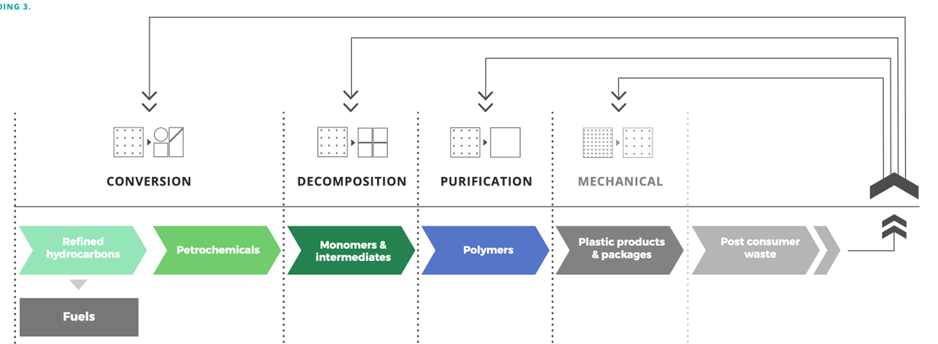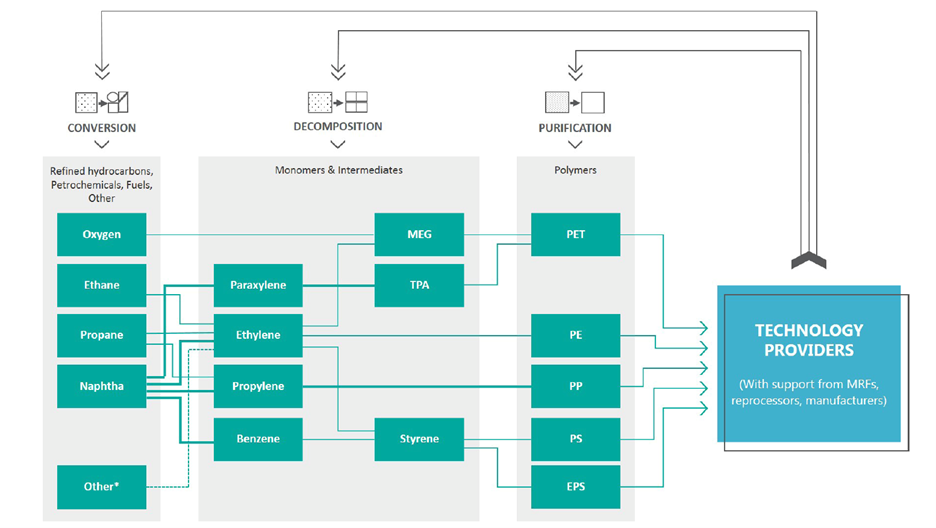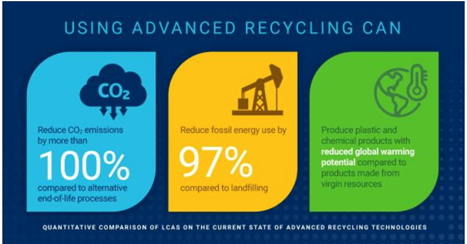In This Section
With only about 9% of all plastics, and 1% of flexible plastics, mechanically recycled in Canada, and with even the most advanced waste management countries in the world only able to mechanically recycle plastic up to ~ 40%, other recovery technologies need to be implemented, in a complementary manner with mechanical recycling, to divert more of these valuable materials from landfill and the environment.
Advanced recycling (also referred to as ‘Chemical Recycling’ or ‘Molecular Recycling’) is an umbrella term for a variety of innovative technologies, which can help to recover valuable plastic materials such as plastic packaging. Through chemical transformation, advanced recycling can capture the full value of end-of-life plastics by using them as raw materials for new plastic products.
Advanced recycling offers the potential to produce recycled plastic resins that are indistinguishable from virgin materials in properties, performance, and applications. Unlike mechanical recycling, advanced recycling seeks to maintain the critical material properties of the resin during the recycling and repurposing process. It also is more tolerant of contaminated feed stocks that are not suitable for the current mechanical recycling processes, while also able to transform more challenging plastic products such as mixed material applications (e.g., toys, multi-material packaging, and other complex products).
The Technology behind Advanced Recycling
“Advanced Recycling” – technology processes can be divided into three technology categories: 1) Purification; 2) Decomposition; and 3) Conversion, which are defined by the outputs that they produce(1). The following schematics are taken from a recently published report by Closed Loop Partners (2)


Advanced Recycling technology providers are transforming the plastics supply chain as they demonstrate real opportunities to reduce our reliance on fossil fuels and start transforming plastics waste into a renewed resource throughout the supply chain. The pathway of possibilities for creating new products with conversion are endless (but generally require more energy), while the pathways with decomposition and purification are more restricted (but generally require less energy).
The illustration below shows where the different processes impact many of the chemicals, monomers, and intermediates that become the most common plastics in use today.

Advanced Recycling Technology Challenges
The commercialization of advanced recycling technologies faces several key technical and economic challenges, notably the feasibility of working at an industrial scale, competing with established recycling technologies and systems, and effective integration of advanced recycling technology into a plastics-based circular economy(3). Consequently, considerable investment and partnerships are being established to explore and validate applications where advanced recycling can effectively and efficiently address these challenges and help advance the plastics circular economy(4)
Technology Maturity & Availability
Many firms in North America and around the world are actively partnering to develop and implement advanced recycling technologies at scale to remedy the limitations of mechanical recycling. Several advanced recycling systems are operating commercially today, however advanced recycling technology isn’t expected to be fully commercial for several more years and be complimentary to established mechanical PCR production, which will remain in demand for a wide variety of materials and applications. Assessments of advanced recycling technology readiness levels (TRL) report some technologies such as catalytic cracking being largely already commercialized(5).
Technology LCA studies
The City College of New York Grove School of Engineering released a new report(6) which examined advanced recycling. The report concluded that advanced recycling helps avoid climate impacts, reduces demand for energy resources, and offers key tools for expanding the circular economy. The report was authored by Dr. Marco J. Castaldi, professor of chemical engineering and director of CCNY’s Earth Engineering Center (EEC), and EEC research associate Lauren Creadore.
The authors examined 13 recently completed life cycle assessments (LCAs) and found that advanced recycling can transform hard-to-recycle plastics into products with a smaller carbon footprint than those made from new resources. The processes also reduce energy use and greenhouse gas emissions compared to conventional end of life methods, such as landfilling and waste-to-energy. Use of advanced recycling contributed to circularity for plastics in all 13 LCAs.

References:
(1) A Roadmap to Support the Circularity and Recycling of Plastics in Canada – Technical Standards, Regulations and Research. Canadian Standards Association. September 2020.
(2) Closed Loop Partners report https://www.closedlooppartners.com/research/advancing-circular-systems-for-plastics/
(3) Chemical Recycling: Status, Sustainability, and Environmental Impacts. Rollinson & Oladejo. 2020 (https://www.no-burn.org/wp-content/uploads/CR-Technical-Assessment_June-2020.pdf)
(4) ‘Infinite Cycles: Canada’s Innovation Competitiveness in Chemical Plastics Recycling’, The Conference Board of Canada, July 2022
(5) Solis, M. & Silveira, S. Technologies for chemical recycling of household plastics – A technical review and TRL assessment. February 2020. Waste Management 105:128-138
(6) Study advanced plastics recycling City College of new York https://www1.cuny.edu/mu/forum/2022/10/12/ccny-study-advanced-plastics-recycling-yields-climate-benefits/